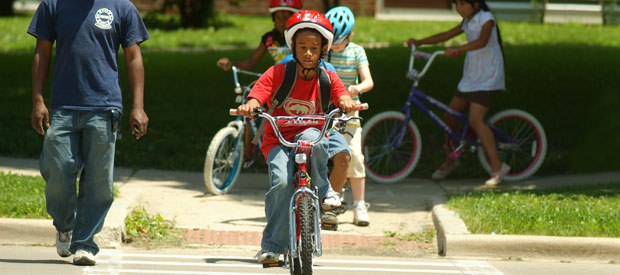
State Network Project News
2015 Update to the State Network Project
In February 2015, funding for the State Network Project came to an end. From 2012 to 2015, the State Network Project was successful in advancing Safe Routes to School, shared use, and Complete Streets policies in the states of CA, FL, MS, NC, NJ, OH, and TN. Our commitment to these states and the field will continue. We will continue to work with advocates across the country on policy change through our national staff working on technical assistance and federal, state and local policy. We are proud of the momentum that we, along with our partners, have collectively generated in these states for Safe Routes to School and active transportation, and know the momentum will continue to be sustained.
2012 Update to the State Network Project
The Robert Wood Johnson Foundation (RWJF) has provided a three-year renewal grant of $2,999,725 to the Safe Routes Partnership, a diverse, nationwide coalition of more than 550 organizations. The grant will support the Safe Routes Partnership’s efforts to advance Safe Routes to School, a federal program that creates safe, convenient and fun opportunities for U.S. children to walk and bicycle to and from school.
“This program will help a generation of children to become more active and healthy through the construction of lasting street-scale improvements that will result in more walking and bicycling,” said Deb Hubsmith, director of the Safe Routes Partnership. “We are grateful for the Robert Wood Johnson Foundation’s generous support, and look forward to working with many partners to help reverse the childhood obesity epidemic in the next three years.”
The grant will build on policy wins from recent years, and advance built environment improvements in all 50 states and the District of Columbia. This project will result in thousands of more miles of sidewalks and bike paths, traffic-calming projects and safer street crossings, and will enable many more students to benefit from Safe Routes to School. The project will focus on supporting communities with high rates of childhood obesity.
The Robert Wood Johnson Foundation is leading national efforts to reverse the childhood obesity epidemic by 2015. This grant contributes toward that goal, and has four main elements:
- Helping all states to increase the award and obligation of federal Safe Routes to School funds, resulting in the construction of bicycle and pedestrian facilities nationwide, particularly in lower-income communities;
- Developing a national learning network to share best practices among advocates for advancing street-scale improvements, such as sidewalks and pathways and joint-use agreements that develop opportunities for cities and schools to collaborate on creating safe places for kids to play and engage in healthy physical activity;
- Advancing state-level policy reform in seven states (CA, FL, MS, NC, NJ, OH and TN), which will result in the award and obligation of federal transportation funds, street-scale improvements and joint-use agreements. Each of the seven states has a full-time advocacy organizer working for the Safe Routes Partnership. The seven states were selected based on need and their capacity to succeed with the program goals; and
- Publication of two policy reports highlighting the importance of the built environment in relation to improving health.
The Safe Routes Partnership was founded in 2005 and is leading a national movement designed to make it safe, fun and convenient to walk and bicycle to and from school and in daily life. In 1969, approximately half of all school-age children walked or bicycled to school. Today, only about 13 percent of children in America walk or bicycle to school. Since 2005, Congress has dedicated funding for state departments of transportation to provide grants to schools and communities to build pedestrian and bicycle infrastructure and run educational programs to support more walking and bicycling. A growing body of evidence confirms that community and street-scale improvements to the built environment play an important role in increasing physical activity for children and adults.
Read more about key results of the State Network Project on RWJF.org.
Reports
- Safe Routes to School State Network Project Final Report, 2010-2011: Phase II - Successes and Lessons Learned
- The Second Wave: State Network Policy Changes in 20 States
- State Network Policy Successes, December 2010
- Safe Routes to School State Network Project: Final Report, 2007-2009, Making Change Through Partners and Policies
- Safe Routes to School State Network Project: 2008 Annual Progress Report - Building Momentum and Policy Change
- Safe Routes to School: Improves the Built Environment
- Safe Routes to School: State Networks Create Policy Change
- Establishing a Safe Routes to School State Network: A 10-Step Guide

